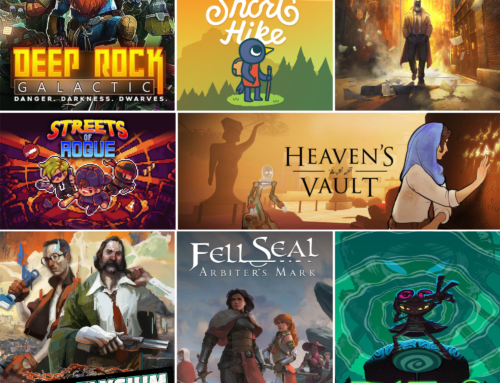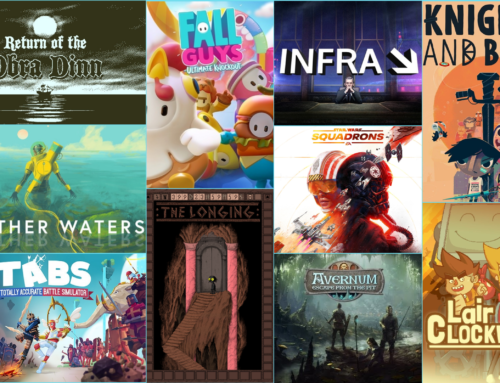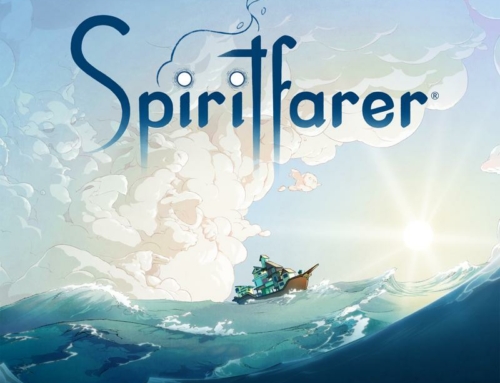An Open Letter Series
Welcome to Game Club, where Joanna Price and myself exchange letters about a game we’ve jointly played. This week, we’re discussing Night in the Woods, the full-length follow-up to Longest Night and Lost Constellation. All the letters are collected here for your perusal, as well as some of the many screenshots I took.
Letter 1
Hey Dylan,
I quite enjoyed Night in the Woods, a game which used platformer, puzzle and point-and-click adventure mechanics, as well as a gorgeous aesthetic to tell the story of a teenager named Mae with a murky past coming home after she drops out of college.
Her parents, who clearly love her, seem to take a hands off approach as she navigates readjusting to small town life for much of the beginning of the game. But it is revealed that they are very involved in helping her through bouts of mental instability and aggression, working hard to get her into college. Given all of this, there is a real question about the likability of the main character which can get in the way of playing for a lot of people. That is, I think often the immersion breaks when a person feels alienated from the character he or she is supposed to be playing.
That said, the way Mae expresses the frustration of stagnation, and the way the supernatural elements of the story interact with the theme of the abandonment of small town America are moving. For me, despite Mae’s often frustrating tendencies, it was hard not to feel for her and the hand she had been dealt. I think one thing this game does quite well is challenge our notion of what empowerment is and how it works. More specifically, outside of the troubles the small mining town she lives in are facing, the constraints that her own perspective enforces on her experience affects the amount of agency she has. I guess the point I’m trying to make is that there’s a largely unexplored truth about the relationship between perception and power that works exactly as objectively (not more or less) than social constructs that are external to us, but include us, do.
I think the ending was a little heavy-handed, but I don’t actually mind that element — I think it’s fair to expect a large gaming audience to be diverse enough to include people whose skills sets lie in other places besides detecting literary themes. As librarians, we obviously are proponents of accessibility and I think the end of the game in some ways makes certain ideas that are thematic throughout the game accessible.
I’m curious to know what you thought about the way the social relationships in the game develop, and whether you ended up sympathizing with Mae or resenting her, or anything in between.
Letter 2
Hey Joanna,
I also greatly enjoyed Night in the Woods. You mention the ways narratives, and the way they’re told, can break our immersive space. This is a very common problem for me in video games, largely because of the way they’re made, with the mechanics and levels set first and then writers told to magically make it all make sense. This leads to a lot of situations where games exist in opposition to themselves (ludonarrative dissonance as well as more traditional nonsense). [1]
In contrast, Night in the Woods is a game that feels organic, that is chock full of content and characters but doesn’t have a single scene that feels out-of-place. I’d guess that the world, stories and characters were fleshed out by the team in an iterative fashion, riffing on itself over the years of development and building an increasingly layered world.
The world, as you note, has two centers: protagonist Mae Borowski, and Possum Springs (her hometown). It’s pretty typical for a setting to be the best-developed aspect of a game’s narrative (it’s something the medium excels at), but much less common to have such a distinct protagonist. To answer your question: at no point did I feel put out by Mae’s antics or otherwise feel alienated, and I’d like to talk about why she (and all the other characters) work so well for me.
As some general background: you know that my relationship to empathy is different from most people’s. One way I’ve seen this manifest is that, with a few rare exceptions (GABRIELLE!), my objections to fictional characters is exclusively formal; I dislike characters when they are poorly written, or lazy stereotypes, etc. But I embrace any character that is fleshed-out and honest, even if they have issues – because ALL people have issues, those issues make them human, and the screen presents a certain distance that allows me to feel compassion rather than be annoyed. Even if that weren’t the case in general, I’d still feel for and root for Mae; she is an earnest, honest, sincere character, and I find that very endearing. Plus, insofar as she’s a screw-up and causes problems for those around here, this is primarily a result of A. mental health issues, and B. being a teenager. As someone who was once a teenager with mental health issues, empathizing isn’t that hard. I only see people being alienated if they have forgotten what it is like to be young, to be confronted for the first time with all the existential issues of “what is my place in the world?” and “where do I go from here?” combined with – as your yourself say – limited experience resulted in a narrow perspective that constrains your options. But I don’t want readers to think that Mae is just a sad sac – she, like all of the characters in Night in the Woods, has an abundance of charm and no shortage of wit.
I also wanted to talk about the platforming elements. I’m pretty lukewarm to platforming in general, but here I loved how integrated it was into the story and Mae’s character, and how it’s really just a method of vertical exploration (in the entire game there is only one tricky jump and it’s for something completely optional). On the rooftops, Mae found an abandoned float where, over the course of days, I raised baby rats. Mae met Lonni and Germ, and had adventures with them (Germ is actually my favorite character in the entire game). And every day going back and visiting these people and areas and checking up on them gives the main story some breathing room.
In fact, for people less invested in it, it might be *too much* breathing room. From a plot perspective, the game is really slow-paced; the ending is abrupt not because it comes too soon, but because the game has a lackadaisical pace until it suddenly decides to wrap things up. I agree with you that it was heavy-handed, and I don’t mind that part; but I did feel that the developers wrote themselves into a hole (in this case, literally), and their solution seemed to be to suddenly and abruptly fill the hole (again, literally). The problem was that in the late game it suddenly moves to much larger stakes than just the personal problems of its main cast, but the writers seemed to realize that focusing on this risked overwhelming all the fine detail they had built up. The ending, like the rest of the game, is consistently *interesting,* and it’s very brave (they could have easily just made a slice-of-life game and left aside the supernatural issues you mention); at the end of the day I think Night in the Woods would probably be a more *popular* game if it was just a story about a college drop-out figuring out life, but it would be less distinct.
On a final note, this game is much more reactive than it appears. There are all sorts of things you can find, or dialog choices you can take, that create differences further in the game; and unlike The Walking Dead, or Revolution 1979, or Dreamfall: Chapters, at no point does the game make any declarations about this. It presents itself as a typical adventure game, and it’s a pleasant surprise when things that seemed like one-off discursions come back in the form of character or world development.
Oh, and to answer your final question – I thought the relationship developing was handled really well. There’s always something a little oversimplification about the way games handle relationships procedurally (time spent between X and Y increases Relationship Status) but this is a lot better than a Bioware game, because the relationships are more equitable; Mae isn’t a hero solving everyone else’s problems, but rather someone in need of help who nevertheless can improve the lives of those around her (which in a sense, describes most of us).
Letter 3
Hi Dylan,
I like your observation that there is a fluid relationship between the visual and playable elements of Night in the Woods and the narrative, and I agree with you wholeheartedly that it is rare to find a game that works so well in that regard.
There are two reasons why I think a player might feel alienated from Mae: the first is that Mae has a history that the character has no control over, does not know going in and has to reckon with. In that sense, we don’t play Mae, so much as manage Mae some of the game. While many games feature playable characters with existing pasts, they don’t necessarily feature as much in the playable story. To the extent that they do, usually all of the information is there already and is basically about creating a believable premise. I think it’s likely that some players will not want to play a character who is accused by NPCs of having done something that is not yet explained– where the NPC and the character that is supposedly getting played know something the player doesn’t! That can be alienating but is not necessarily a bad design choice at all, just an observation. Secondly, you are right that Mae gets out of being a sad sac with wit and charm. Yet, many of us know someone who is precisely this way: extremely irresponsible, often to the point of unethical treatment of others, and yet very charismatic and charming. It’s one thing to encounter such a person, it’s another thing to play her. She is — in that way at least — an antihero. And while she doesn’t outright lie, I would not really typify her as earnest, sincere or honest. I’d say she is skeptical, sarcastic and often holds back. She is very likable but mainly because we can see who she is despite herself, which makes sense — teenager and all.
The slow pace of the game ended up being a lot more enjoyable than I anticipated. That lent an immersive aspect that reminded me of watching a really good TV series, where you feel like you’re with the characters and the story for a significant amount of time. I’d love to read something on the relationship between time spent with a particular media and effect, taking for granted here that there the media we consume does affect us. 🙂
A new thing I want to mention is the question of the generational skip, Mae was extremely close to her grandfather, and I feel like there’s something there to be explored. Why does a small town, middle American teenager feel most connected to her grandfather? And more specifically, how does that tie into the theme of ghosts and ghost stories? These aren’t leading questions, I don’t have answers preset in my mind. I’m really curious what you think.
Letter 4
Hey Joanna,
I definitely see what you’re saying about potential difficulties with Mae. One of the most ancient design problems in video game is how to get the player’s knowledge of the world to match their character. The straightforward way to deal with this – having other characters explain things about the world, or having the player character ask lots of questions – is clearly immersion breaking and doesn’t make diagetic sense (but lots of games do it anyway). Another common solution is to simply make the player character a blank slate, have amnesia, or themselves be a Stranger in a Strange Land, so that they learn things at the exact same time the player does. But this significantly limits the writers in how they can define a character and the situation they’re in.
Starting in media res, as Night in the Woods does, doesn’t even try to tackle this problem; instead it says, you know what, this isn’t inherently a problem for the story we’re telling, and how we’re telling it. As you said, we merely manage Mae; we are not required to leverage her knowledge of past events, or her world, and this setup engages the player with a dual mystery; one focused on the past (Mae’s past, and the past of Possum Springs) and one focused on the present (the more straightforward Whodunnit). This is a pretty classic framing for mystery stories, and the only unusual thing here is that the focus is very much on the former thread. I think the reason it wouldn’t even *occur* to me to be bothered by it is that I engage with Night in the Woods much like I engage in more passive fiction, and that has a lot to do with my expectations of the genre it occupies. If I went in expecting a roll-your-own-character RPG, and instead got this, I *would* be put out – but outside the Kickstarter PC RPG renaissance those games are still pretty rare.
I think the pacing also takes the edge off. Absent the studies you imagine (and I too would be interested in reading them), I think it’s safe to say that there is a correlation between time spent with something and how comfortable we find it (because comfort is simply pleasant familiarity). The fact that we get to spend time in Possum Springs, and with Mae, without any particular pressures or rush helps us settle in – and at the end we probably don’t want to leave. (I think this also partially explains why so many people watch TV shows well past the point when they’ve jumped the shark).
Mae’s relationship with her grandfather is actually one of the more clear-cut things in the narrative, at least if we take Lost Constellation into account. We know that Mae’s family are immigrants a few generations removed from their native land; her parents are entirely Americanized, and more or less accept everything about Possum Springs and reality as most people understand it; they are straightforward, working-class Christians. But Grandfather still retains a connection to the old country, and particularly its mythology, its folktales, and its embrace that there are things yet unseen and unknown in the world. As a precocious small child, Mae loves these stories because they are so much more interesting and evocative than what she gets at Sunday school; and I think as Mae grows up and ‘doesn’t fit in,’ there’s an increasing connection and association with the otherness of these stories. And, of course, these stories come to life in the present-day plot of the game!
One of my favorite subplots is her grandfather’s membership in the weird little tooth cult; it turns out that he did not merely retell the stories of his homeland, but also maintained the history, and created the mythology, of his new home in Possum Springs; and by passing the tooth on to her father, he too can get inducted into the role of curator and storyteller.
There’s a lot more we could say about this, but I know we both have busy lives, so I’ll just conclude that Night in the Woods is one of the most confident and enjoyable storygames I have ever played. I can already tell that it’s going to age gracefully, and I expect to be recommending it for many years to come.
Until next time,
Dylan
- [1] An example of this from today’s gaming: I was exploring the ruins of an ancient, long-extinct civilization in The Elder Scrolls Online, and came upon some bookshelves with still-intact books. I read a few…and found that they were all contemporary, published centuries after the ruins’ occupants disappeared. The developers, it appears, had written a script to randomly insert books on bookshelves throughout the gameworld, and had either forgotten or simply not bothered to modify that script for long-uninhabited areas. Suffice it to say that this completely destroyed any immersion I had. ↩


















Leave A Comment